It’s A London Thing: Bringing the “Caribbean” to the UK
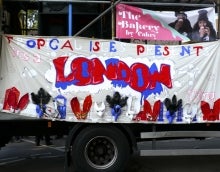
The post-World War II mass migration of communities from the Caribbean to England has had a tremendous impact on the cultural landscape of the United Kingdom. In my initial attempts to begin constructing an understanding of this impact, the perception that “tradition is not a static construct” and that “boundaries . . . are not rigid but fluid possibilities” (Friedson 1996:7) raised particular questions regarding cultural productions among the displaced Caribbean population in England: 1) is it even possible to “bring the Caribbean Islands” to locations outside of the Caribbean; 2) what happens to the culture as it interacts with a new environment; 3) what impact does this have on the formation of a cultural identity; and 4) what strategies and institutional structures are in place to see that the culture is maintained?
As a result of these questions, I traveled to London, England during the summer of 2013 (July 26 – September 2) in order to conduct fieldwork that investigated Afro-Caribbean cultural retention, adaptation, change, and innovation in England among the black British population. Moreover, I was interested in the ways in which black Britons of Caribbean descent utilized their cultural traditions to transform and enhance their lived experiences in the nation’s capital. After nearly six weeks of participant-observation at numerous events such as the London Calypso Tent, UK Soca Monarch, and the Notting Hill Carnival, as well as conducting interviews with individuals whose specialties involved the preparation of Caribbean dishes, Carnival arts, and music performance, I witnessed first-hand the rich array of Caribbean culture in England and its contributions to contemporary British social life.
Living and “Liming” in Deptford
For the duration of my stay in England, I resided in the Metropolitan Borough of Deptford, which is located in southeast London. One of the immediate things I noticed about the area was the high-level of black and Asian presence in this particular borough. What was even more remarkable to me was the vast multiplicity of African, Caribbean, and Asian people represented in the area, as opposed to a singular “ethnic” community. Therefore, on any given day, the diversity of the community can be witnessed simply by walking the streets of Deptford. However, on Deptford Market Days (Wednesdays, Fridays, and Saturdays), the diversity of the community greatly intensifies, as hundreds of people from around the city pour into this area to shop.
On Saturday, July 27th, which was a market day, I decided to walk around Deptford for the primary purpose of better acclimating myself with the area, but I did not have any grand plan or a specific destination toward which I was heading. In a way then, I was participating in a “dérive” of sorts, and by dérive, I am referring to a “technique of transient passage through varied ambiences” that “entails playful-constructive behavior and awareness of psychogeographical effects” (Debord 1996). In other words, I was drifting and allowing the environment to dictate where I should go. As I was “drifting” around Deptford, I noticed tons of different products being sold at the market including food, clothes, jewelry, electronics, CDs, etc., and I took pictures of the various shops, restaurants, and stalls. The following pictures illustrate the diversity of business in the Deptford area.
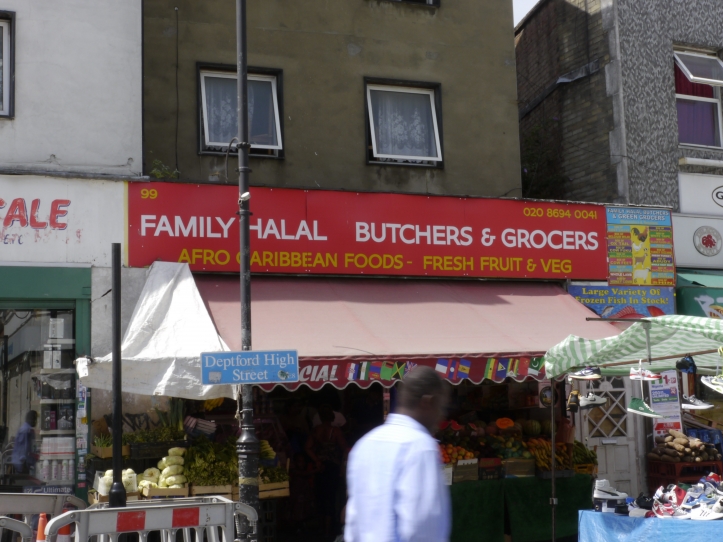
Local grocery store specializing in Afro-Caribbean foods located on Deptford High Street.

Miscellaneous items being sold at the Deptford Market.
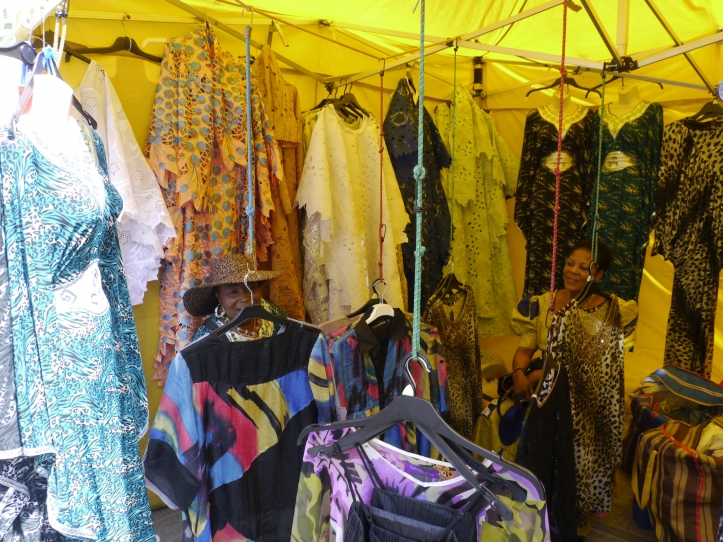
African dresses being sold by Nigerian vendors at the Deptford Market.
After having walked the entire Deptford High Street, I decided to double back. While doing so, I noticed a cross street (Douglas Way) that I did not see the first time and decided to head in that direction. As I was walking up Douglas Way, I could distinctly hear the sound of reggae coming from some speakers. Although I could not see exactly where the music was coming from, I decided to follow the sound source. It led me to this food stall entitled “In A Pikkle,” and while reading the signage on the stall, my eyes came across the words “Barbadian food.”
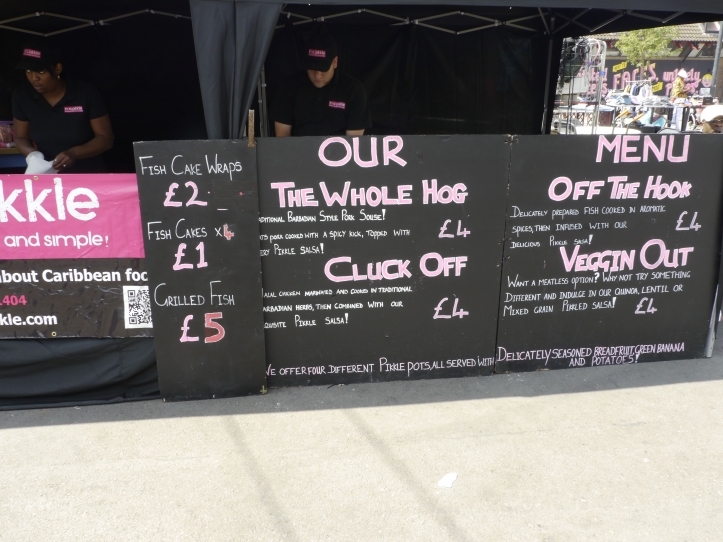
“In A Pikkle,” an outdoor food stall specializing in Barbadian and other Caribbean foods.
After a few moments of reading, I was greeted by the workers who were extremely warm and pleasant. Karen Alleyne, one of the co-founders of “In A Pikkle,” along with Mark Quinton, began to tell me that the food they were selling was known as “souse,” which is a traditional Barbadian meal eaten on Saturdays that consists of “slow-cooked pork, marinated in limes, onions, and garlic peppers, and normally comes with black pudding.” Instead of simply duplicating the recipes, Karen told me that they [her and Mark] “took that concept and added chicken, shrimp, smoked mackerel, quinoa, mixed beans, and porcini mushrooms.” Below are some images of the food I was served.
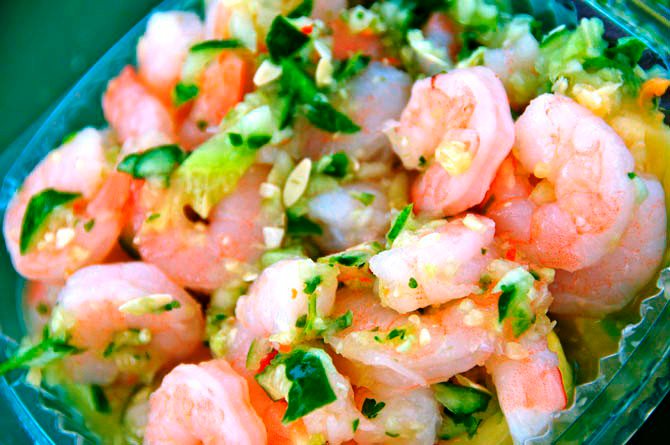
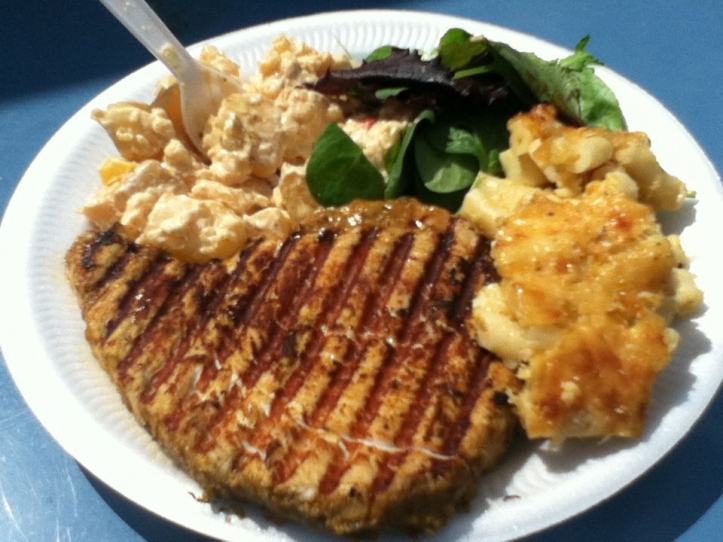
Karen then invited me to “lime” (socialize) with them over souse and “tea” (usually Mount Gay rum and coke) in order to experience the food and learn more about their culture. While liming, Karen told me that after returning to live in London from Barbados, she and Mark got the entrepreneurial idea to start “In A Pikkle” essentially because “no one in London was selling souse,” so they begin to sell it from their house. She went on to say that they “started with five people, then every Saturday there were about 150 people that would come to the house and they would not leave until 6-7 o’clock in the morning.” From this humble beginning, Mark and Karen have continued to expand their business, and have created a unique brand of Bajan (Barbadian) food that is loved and shared by many. Perhaps more importantly, their business is the epitome of community-building, as I witnessed on a weekly basis how people would regularly travel across the city from various locations just to meet up with their friends to eat and lime at “In A Pikkle.” These regulars are affectionately regarded to as “Pikklers,” and after eating there every Saturday for six weeks, I too became a “Pikkler.” [1]
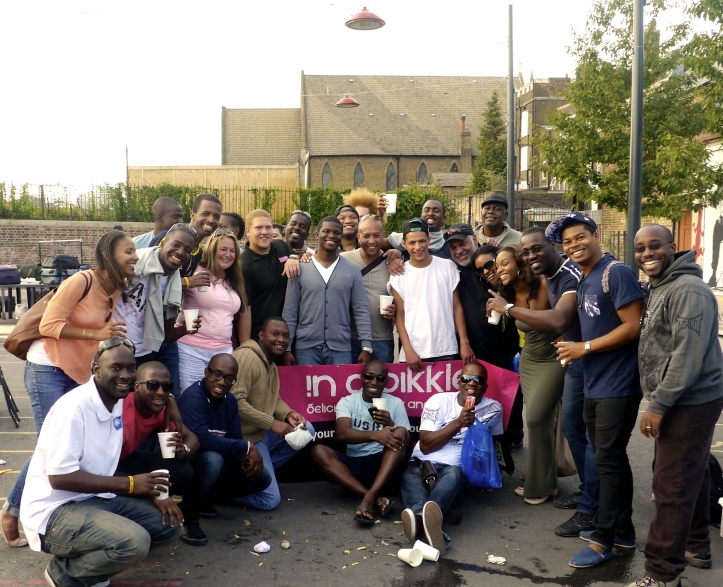
Photo of the author (center-left) and a group of “Pikklers.”
Carnival Arts and Playing Mas in London!
Months before carnival, mas bands decide on a theme and commission designs for the costumes that will explore, illustrate or fantasize on the chosen idea. The theme may tell a story from history or legend or celebrate Caribbean life and island beauty; it can be satirical and political, commemorate an event or transform the everyday world with fantasy [emphasis added]. (Tompsett 2009:4)
I incidentally met Mr. Carl Gabriel, an artist who specializes in Carnival arts, at the Yaa Asantawaa Centre while traveling there to observe the rehearsal of the Ebony Steelband (steel pan musicians). When I walked into the facility, I was immediately surrounded by these beautiful sculptures and I noticed a man [Mr. Gabriel] slumped over manipulating wire.

From entrance to the Yaa Asantewaa Arts Centre located in West London.

“Wire Sculpture of a Woman” designed by Carl Gabriel, photographed by Deonte Harris at the Yaa Asantewaa Arts Centre.
I told Mr. Gabriel that I was a student researcher from the United States and that I was interested in learning more about Carnival arts in London. After introducing myself and my purpose for coming, he began to share stories with me about his involvement in the arts as a photographer, steel pan musician, costume designer, and wire sculptor; the latter, in particular, has earned him international recognition. At the Yaa Asantewaa Centre, he, along with his wife Lynn Gabriel, construct 3-D wire Carnival structures, and they also conduct workshops that teaches students how to develop Carnival masks and costumes. One of his creations that captivated me most was this huge 3-D sculpture of a female mask that also combined music notation and a steel pan as a part of its construct.
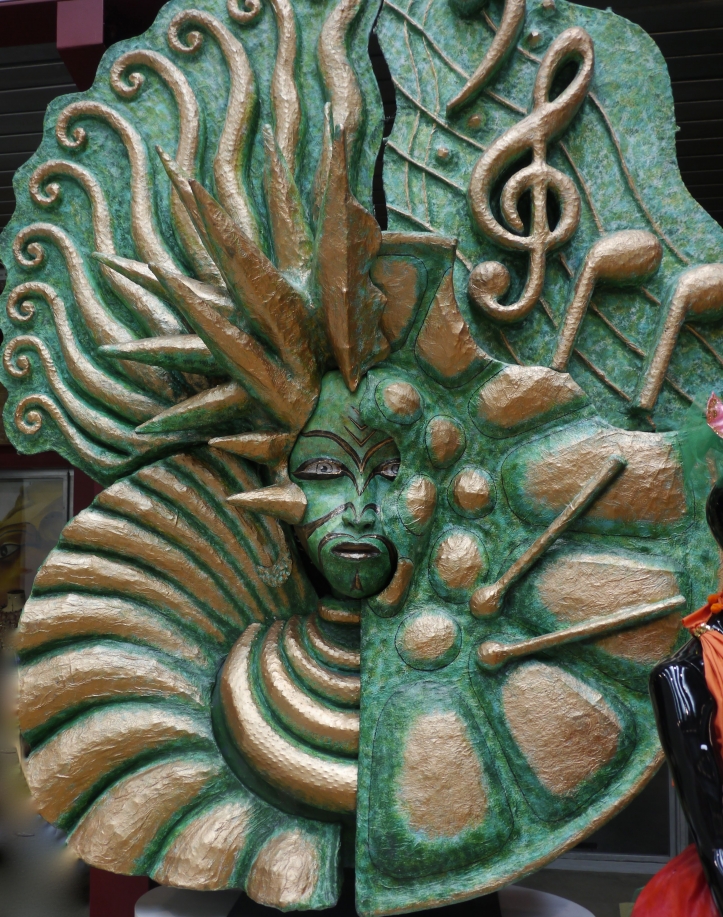
“Female Mask and Steel Pan” designed by Carl Gabriel, photographed by Deonte Harris at the Yaa Asantewaa Arts Centre.
Beneath the sculpture, it reads: “This trophy has been created with the combined discipline in mind. It shows a female mask incorporating a steel pan. The overall image reflects the strong relationship between the Carnival costume and Steel Pan” (Carl Gabriel 2004; emphasis added). This inscription attests to the marriage of masquerading and music in the spirit of Carnival. For the 2013 Notting Hill Carnival, the Yaa Asantewaa Mas was themed “Celebrating Obama,” and their costume designs and wire sculpture reflected the various aspects of President Barack Obama’s background (an American of Kenyan descent). This can be seen in the following photos:
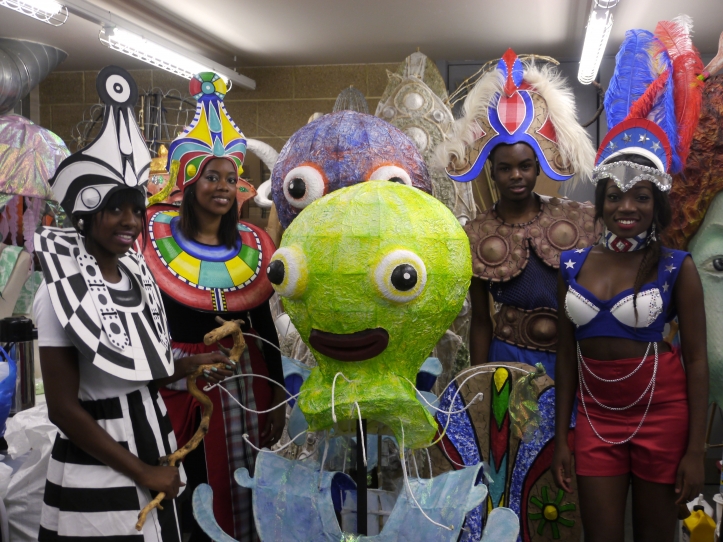
Costume designs inspired by U.S. President Barack Obama’s Kenyan and American heritage. From left to right (two female Kenyan costumes, one male Kenyan costume, and one female American costume). All costumes were created by Carl Gabriel, photograph by Deonte Harris.
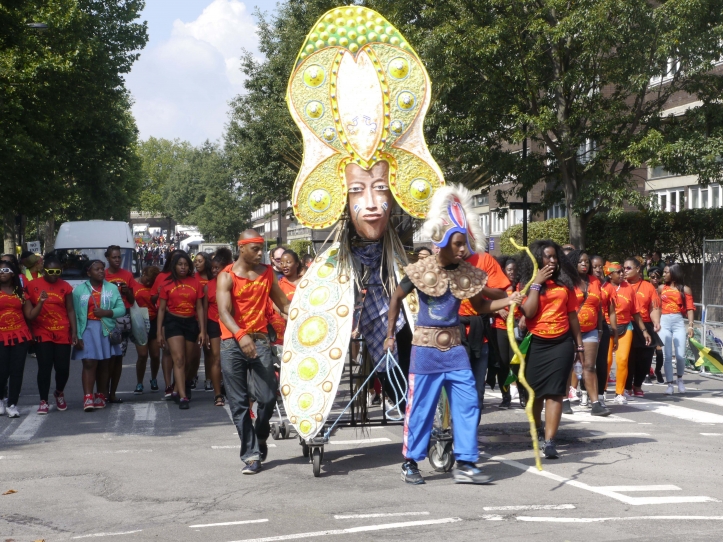
Yaa Asantewaa Mas Band at the 2013 Notting Hill Carnival: Kenyan male costume and Kenyan wire sculpture located center.
On the same side of town as the Yaa Asantewaa Arts Centre in West London lies another great institution that promotes and maintains Caribbean music, arts, and traditions; that place is called the “Tabernacle.”
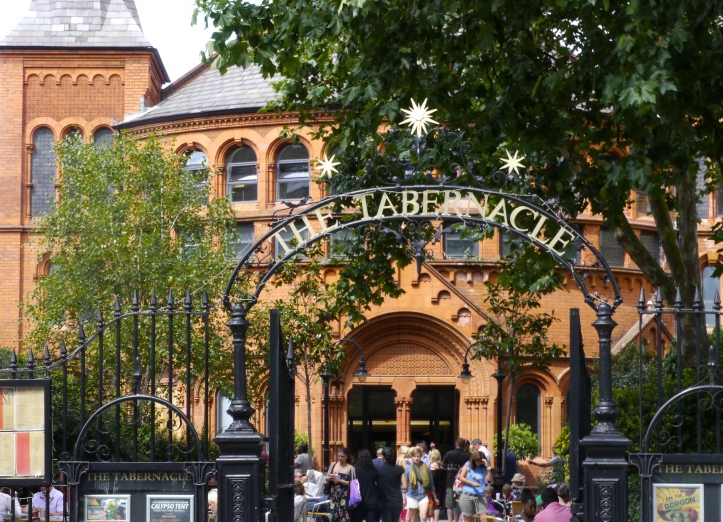
It was at the Tabernacle that I viewed the premier of a documentary on the calypsonian Black Stalin entitled Come With It, Black Man, and it is also where I learned about the London Calypso Tent that would be taking place there. While talking to the stage crew and soundmen an hour before the Tent was to start, I incidentally stumbled upon a group of women working on costumes for the Notting Hill Carnival. They belonged to a mas band known as Genesis.
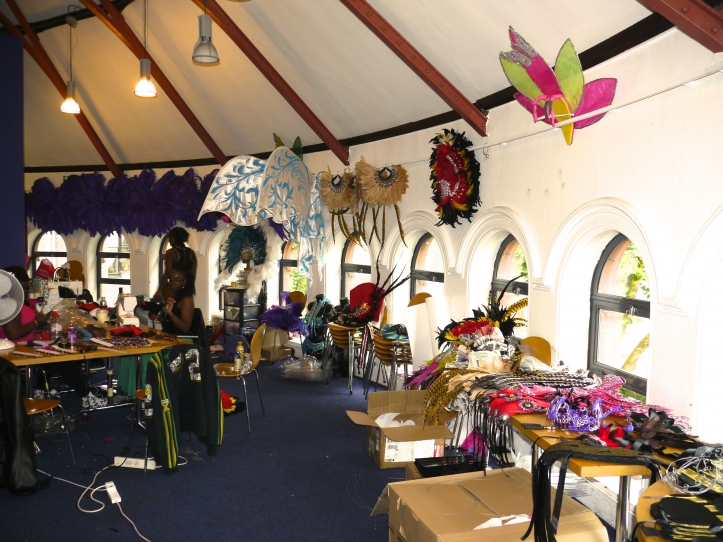
Genesis Mas Camp inside the Tabernacle.
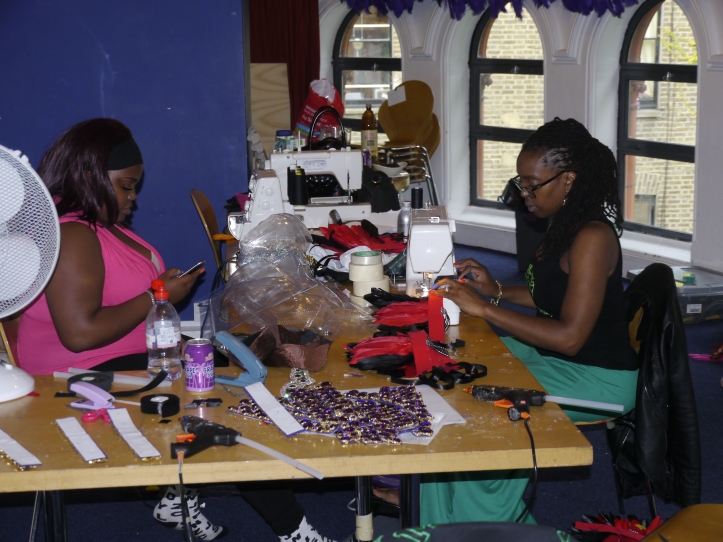
Tamekia Burke (left) and Band Leader Symone Williams-Watson (right) working on costumes for the 2013 Notting Hill Carnival.
“Genesis” is a costume design company that was established in 1980 by Vernon “Fellows” Williams (one of the founding members of the Notting Hill Carnival in the early 1960s). For 33 years, the mas band has been one of London’s greatest promoters of Carnival arts, contributing not only to the Notting Hill Carnival, but other carnivals throughout the UK, the Caribbean, and in Africa.
I was fortunate enough to have the opportunity to interview Tamekia Burke, one of the costume designers at Genesis, who has been involved in the carnival scene since she was five years old. During my interview with her, I was struck by the concept of “story-telling” through creation and masquerading. For example, when asked about the source of inspiration for designing costumes, Tamekia pointed to one hanging nearby and said, “that purple one is a good example because Symone [the band leader] got married in February and she named that one ‘Tobago Love.’ Purple and gold were her wedding colors and that’s where she got that inspiration from.” In February of 2013, the costume designs of Genesis were also featured in Trinidad’s Carnival. Their theme for the event was “Eden.” In reflecting on their experience in Trinidad, many of the women who were working on costumes stated that being a part of Trinidad’s Carnival was like paradise. As a result of their tremendous experience, the theme for their Notting Hill 2013 masquerade became “Paradise.” Therefore, one can see that the inspiration behind costume designing happens on a personal level as well as on a communal level, and in each case, the costumes are imbued with cultural meaning and value. When I asked Tamekia about how important the costumes were for carnival, she stated that “there is a lot of passion and effort that goes into making the costumes” and “without costumes, the word Carnival doesn’t have any meaning . . . It [Carnival] is not about sound systems and going out there to cause trouble, it’s actually about telling a story . . . and keeping the culture in it.”[2]
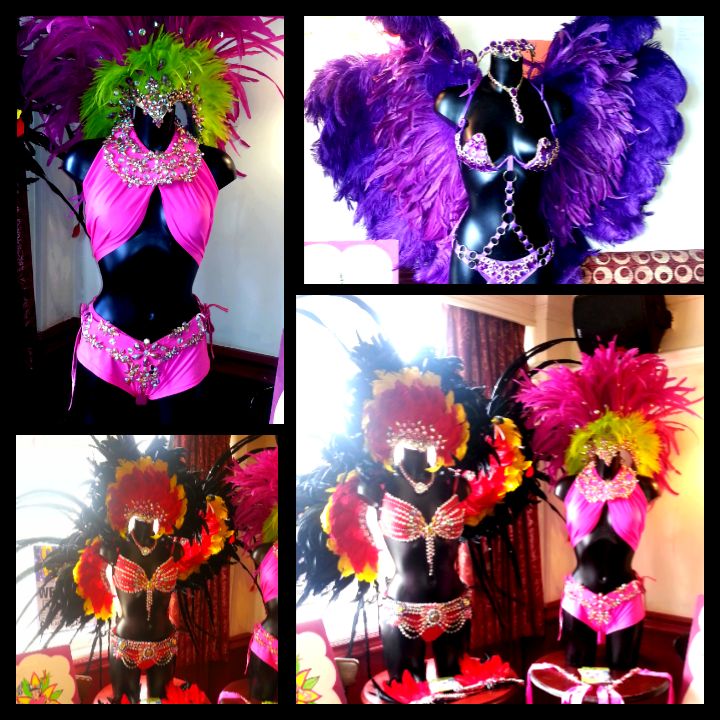
2013 carnival costume designs created by the Genesis Carnival Company.
Triniboi Joocie and UK Soca
Anytime you hear soca in the UK, you may as well introduce me. (Triniboi Joocie Clash of the Cultures mixtape)
My intention is to take soca music where it has never been before, pushing into the mainstream UK market. (Triniboi Joocie, quoted in Blood 2014, “UK Soca Monarch Comes To Trinidad,” in the Trinidad Guardian Newspaper.)
One of the last questions I asked Tamekia Burke during my interview with her at the Genesis mas camp was what type of music she liked to listen to. Without much hesitation, she said Caribbean soca because of its energy and positivity. Not surprisingly, when I attended London’s Notting Hill Carnival, it was soca that, perhaps because of its “energy and positivity,” easily dominated the music soundscape. However, most of the soca music that I heard came from Caribbean-based artists, not local musicians. One of the reasons for this, according to Burke, is that England, as a whole, has not embraced soca music or soca artists yet, and that “here [England], it’s too much criticism and not enough support.” To do soca here, “you have to do a lot of work to get out there and you got to have a support group. Like 24/7, you have to be promoting yourself if you want to try that here.” With local artists like Triniboi Joocie (Rodell Sorzano) touring all over Europe and the Caribbean now, and completely “mashing” up the soca scene, fandom for UK-based soca music should be seeing an increase in the near future; moreover, Joocie, in particular, is positioning himself to be at the forefront of that movement.

2013 UK Soca Monarch Triniboi Jooci
On numerous occasions when I went out in London and a discussion about soca began, Triniboi Joocie’s name was immediately brought up as an artist who is not only tremendously talented, but is taking UK soca to another level. When I had the opportunity to interview him, what became evident to me is that Joocie was a driven visionary from the start. This was apparent even in the choosing of his stage name. In my interview with him, he stated that “‘Trini’ comes from my heritage [Trinidadian], which is very important to my identity. And in terms of performance, any music I make, I want it to be infectious. It has to be ‘Joocie’ [juicy]! You can’t get enough of it. You will want more and you will want more.” Couple this drive with his relentless work ethic and you get an artist poised to take over the soca landscape in the UK. The first steps of this takeover took place this past summer at the 2013 UK Soca Monarch competition, where he won the crown for both the Groovy and Power categories for his performances of “Beautiful” and “Iz We.”
Throughout 2014, the reigning UK Soca Monarch is expecting to do even more recording, more touring, and he is also entering the International Soca Monarch in Trinidad and Tobago. Perhaps most importantly, Joocie is embracing his role as the leader in the development of the UK soca scene.
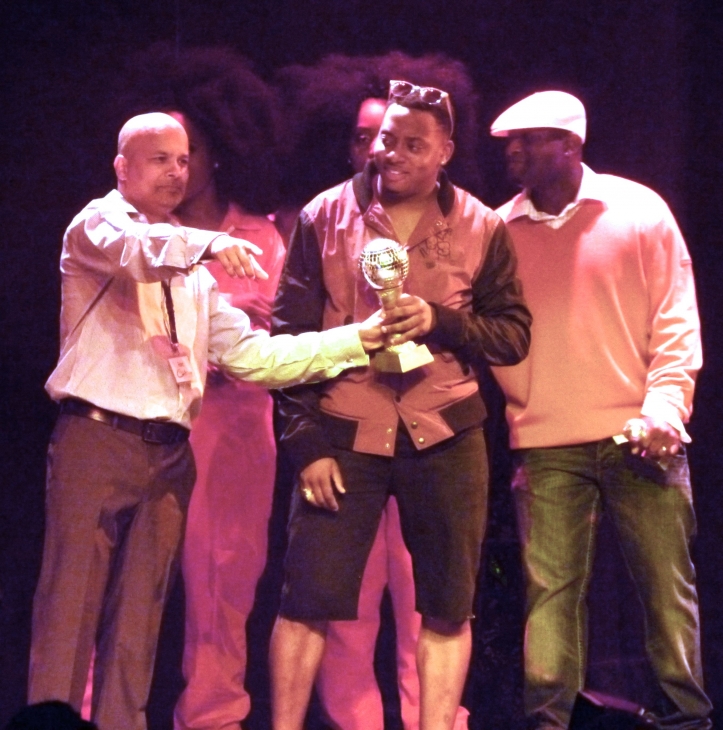
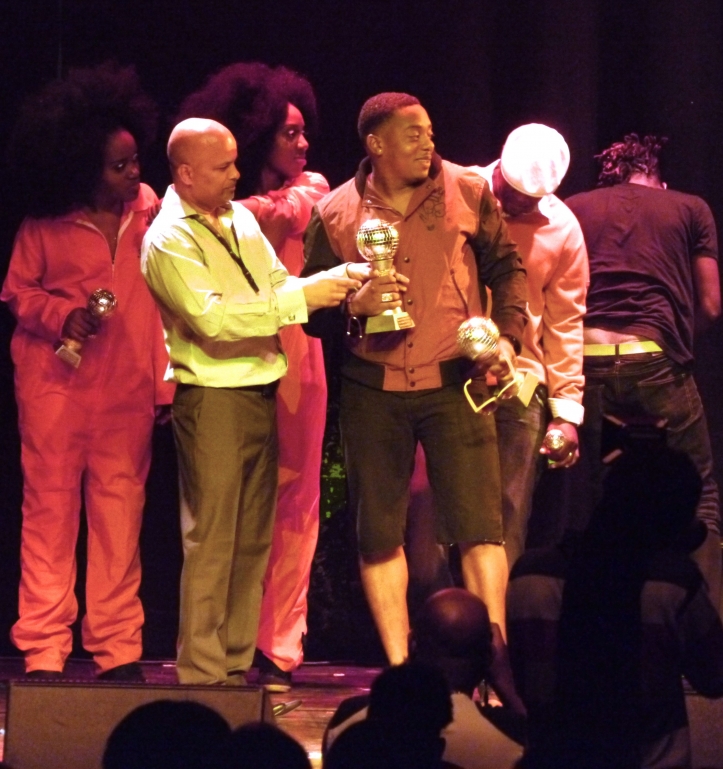
Triniboi Joocie being awarded 1st place in the “Groovy” and “Power” categories of the 2013 UK Soca Monarch.
---
References
Alleyne, Karen. 2013. Personal interview with the co-founder of “In A Pikkle,” July 27, London, England.
Blood, Peter Ray. 2014. “UK Soca Monarch comes to the source.” The Trinidad Guardian Newspaper, January 13, Section - Guardian Media.
Burke, Tamekia. 2013. Personal interview with the Genesis carnival masquerade designer, August 22, London, England.
Debord, Guy. 1996. “Theory of the Dérive.” In Theory of the Dérive and Other Situationist Writings on the City, edited by Libero Andreotti, 22-27. Barcelona: Museu d’Arts Contemporani de Barcelona.
Friedson, Steven. 1996. Dancing Prophets: Musical Experience in Tumbuka Healing. Chicago: University of Chicago Press.
Sorzano, Rodell (Triniboi Joocie). 2013a. Personal interview with the 2013 UK Groovy and Power Monarch and steel-pan musician, August 30, London, England.
________. 2013b. Clash of the Cultures mixtape. Joocie Camp and Zharty Crew.
Tompsett, Adela Ruth. 2009. Carl Gabriel and Carnival Arts. Published by Carl Gabriel.
[1] For more information about “In A Pikkle,” please visit their website (http://www.inapikkle.com/) and Facebook page.
[2] For more information about “Genesis Carnival Company,” please visit their website http://genesiscostumes.com/index.html and Facebook page.





